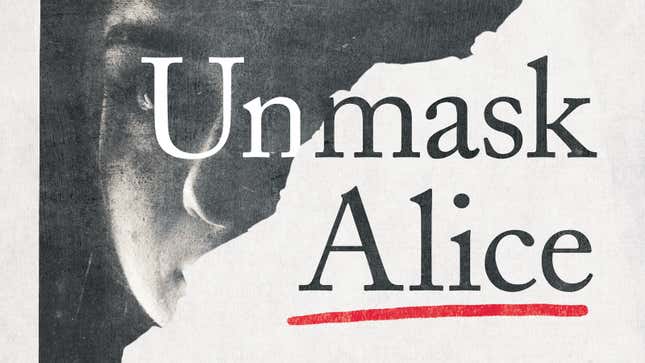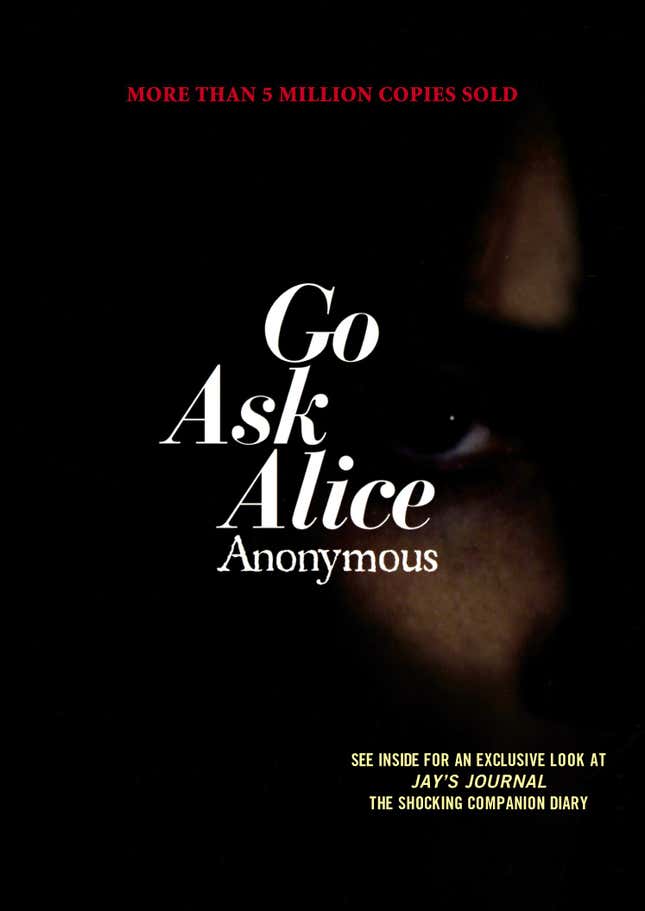The True Scammer Behind the Fake Diary ‘Go Ask Alice’ Duped Millions of Kids
Unmask Alice lifts the veil on author Beatrice Sparks, who fabricated the lives of young adults to moralize about drugs, sex, and Satanism.
BooksEntertainment

In 1971, a frustrated 54-year-old writer named Beatrice Sparks spoke directly to teens by masquerading as one of them. Her disguise came in the form of a book, Go Ask Alice, which was marketed as the “real diary” of a 15-year-old drug user. Alice is as hardcore as any book carrying the “young adult” label ever has been, and its contents were almost entirely invented by Sparks. As such, it is rife with misrepresentations of drug effects that could reasonably be described as disinformation. To have read Go Ask Alice is to be duped. Now, more than 50 years after its release, nearly 6 million copies of the pulp classic have been sold—that’s a lot of fooled kids.
The story behind the grift is spelled out in detail in Rick Emerson’s new book Unmask Alice: LSD, Satanic Panic, and the Imposter Behind the World’s Most Notorious Diaries. “One of the taglines for the book is ‘truth is stranger than nonfiction,’ because if this was just written from scratch, you would never believe it,” said Emerson during a recent Zoom conversation with Jezebel; nothing invented out of thin air could rival this tale.
Emerson said he started writing his book in 2015, and the themes he uncovered are startlingly contemporary. The gateway drug of the book’s narrator (who is unnamed but, because of the Jefferson Airplane-referencing title of the book, most readers refer to as Alice) is not the typical marijuana but LSD, and the book vilifies it to a nearly unrecognizable extent, perpetuating myths of Richard Nixon’s war on drugs that only recent research into psychedelics has started to change minds about. Additionally, Emerson’s narrative manages to weave in contemporary obsessions with scammers, multi-level marketing schemes, and fame. It might not seem like it at the offset, but it turns out that now is the perfect time to revisit Go Ask Alice.

Go Ask Alice details its narrator’s descent into addiction and exploitation. She runs away from home and becomes a strung-out teen sex worker before landing in a mental institution. She resolves to get clean, but the book ends with a tragic postscript stating that three weeks after her final entry, the narrator relapsed and died. The imprecise descriptions of drug use and hokey verbiage in the book, as well as varying descriptions of the book itself (at times it was referred to as “fiction” on its copyright page), aroused suspicions that the diary was not a real document. So did the behavior of Sparks, a Mormon writer who, it turns out, wrote Go Ask Alice based primarily, according to Emerson, on observations and subsequent friend reports of a teen girl Sparks worked with in some capacity as a volunteer at the Utah State Hospital’s Youth Center. (Emerson points out that while Sparks claimed to have performed “professional counseling of troubled children,” her volunteer duties were more likely clerical in nature.)
Despite presenting her book as a sort of found object she had “assembled” from a dead girl’s journals, Sparks pushed to receive some kind of credit for Alice. Her publisher denied her this, insisting that “Anonymous” was a far more compelling attribution. Sparks pressed on. In 1978, she released VOICES, marketed as a collection of as-told-to accounts from four more troubled teens, gathered by the person who “edited” Go Ask Alice. She would go on to “edit” Jay’s Journal, an account of teen suicide and Satanism that sold a fraction of Alice’s haul but was nonetheless widely read. According to author and religious studies professor Joseph Laycock, Jay’s Journal “helped trigger the Satanic Panic” of the 1980s that accused heavy metal and Dungeons and Dragons of turning teens murderous and suicidal.
Emerson writes in his Author’s Note that the idea to write the true story behind Go Ask Alice arrived one day in a flash as he was driving. “I came home and my first thought was like, ‘Well, somebody must have written this. This must already exist,’” he recalled. Upon investigating, however, he discovered that “the most in-depth thing” written about Sparks and her books was still Alleen Pace Nilsen’s “The House That Alice Built,” which ran in the October 1979 issue of School Library Journal. Nilsen’s article questioned Sparks’ stated credentials, noting that though the author frequently claimed to be a youth counselor or social worker, during an interview with Nislen she gave “no evidence of formal training or professional affiliation.” In response, Sparks blasted off a letter to the Journal, claiming Nilsen’s article was “not only incorrect, but in places openly hostile,” and that she had graduated from UCLA as a psychology major. (No record of this supposed graduation exists.)
-

-

-

-

-

-

-

-

-

-

-

-

-

-

-

-

-

-

-

-

-

-

-

-

-

-

-

-

-

-

-

-

-

-

-

-

-

-

-

-








































